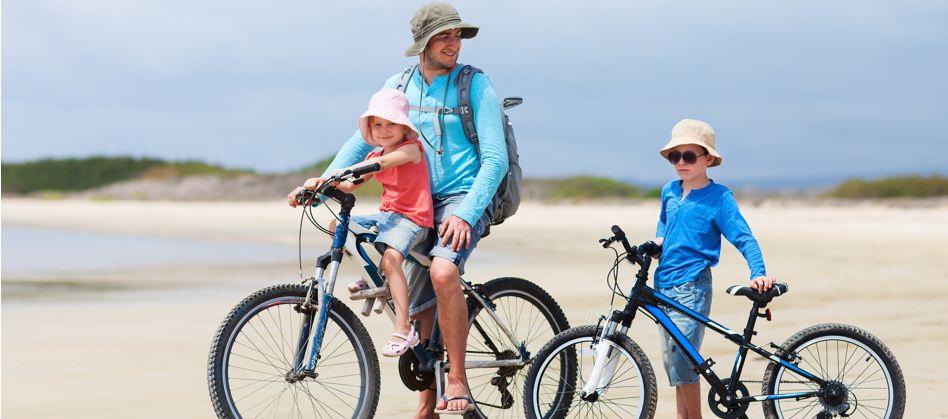No. 2 - At The Beach

Beaches, One of the Coolest Places
At the Beach
SAFETY PRECAUTIONS
Before visiting any beach, especially if family members are entering the water, parents should seek advice about any local dangers. In particular localities, in some countries, there could be danger from sharks, stinging jellyfish, crocodiles, Portuguese men-o-war, rips, collapsing sandbars, submerged rocks and rogue waves. In many countries, if people spend too much time in the sun they risk heat stroke and sunburn. Dehydration may result from not drinking enough water. Beach-goers need to take precautions need to be taken if the risks are high. Sometimes glass from broken bottles is found in the sand near popular areas. Most people pick up broken glass and dispose of it.
Some of These Activities Are Only Relevant To Surf Beach Environments
INVESTIGATE ECOSYSTEMS
Children enjoy studying different environments to see what living and non-living things they can discover. There are various ecosystems in the beach environment such as rock pools, shorelines, mobile (non-vegetated) dunes, fixed (vegetated) dunes, rock platforms, headlands, estuaries and underwater environments. Try and discover 'who eats who' in different locations.
SHELLS
Collecting shells is fun because there is a great variety of them. Colour and shape can be used to sort them. They can be put in order of size or used to make patterns. They can also be used for counting, creating a simple abacus to show numbers and playing games like 'How Many Eggs in the Bush?" Children could learn the names of the more common ones. Ask children to see if they can find a coiled shell that turns a different way to the other coiled shells. The two main groups of shells are gastropods (coiled shells) and bivalves (hinged shells).
HOW MANY EGGS IN THE BUSH?
Players begin the game with seven small objects such as stones or shells. The purpose of the game is to get all the objects from the other player. Players work out a fair way to decide who goes first. The player who goes first hides a number of his objects, or none, in one hand. He closes it and holds it out in front of the other player. The other player guesses how many objects are in hand. If the guesser is correct, the first player gives the objects in their hand to the guesser. If they guess wrong, the guesser has to give the first player the number objects which would equal to the difference between their guess and the number of objects in the first player's hand. Then it is the guesser's turn to hide objects. The game ends when one player has all the objects ... or a rogue wave comes and washes out the game.
TRACKS
While walking on beaches, I have found tracks of lizards, snakes, animals, birds, turtles, humans, crabs, live shells, vehicles, and bikes. At times I enjoy trying to work out the sequence of events by looking at where the track sets overlap. Investigating tracks excites children's curiosity, challenges their minds and improves their problem-solving skills. Encourage children to:
- Identify the maker of each track
- Determine the direction they were going
- Identify individual human tracks by the shape, size and whether the person was wearing a shoe
- Learn the order of events by looking for overlapping tracks
DEAD THINGS ON THE BEACH
Sometimes the remains of once-living organisms are found along beaches. Some of the remains that I have found are from turtles, fish, birds, dugong, sea snakes, coral, shells, seaweed, crabs, starfish, sea urchins and sea cucumbers. The more that soft-bodied animals decay, the more difficult they are to identify. See if children can determine the types of dead animals that is if they can get close enough to them :-) Ask children to share their feelings about seeing the dead animals. Share your feelings, talk about empathy, sadness, grief and loss. Relate this back to the loss of the human sphere, loss of loved ones, pets, and friends.
THE BIGGEST CHALKBOARD
The beach can be a huge chalkboard. Don't make it too much like a classroom lesson, but think of ways for children to write sounds, words, sentences, numbers and do mathematics.
PLAYING TAG
Beaches are great places for playing Tag, but not Hide and Seek.
USING A COMPASS
Using an orienteering compass the four cardinal points, north, south, east and west, can be determined. From there, children can draw in the sand a large, simple compass rose, correctly aligned. First have children draw a large cross and mark the four cardinal points, N, S, E, W. Check with using the compass. Then have them write in the ordinal points, NE, NW, SE, SW. Now have the children determine the bearing to various objects from the centre of the beach compass, e.g. the car park, a large tree, the headland, a boat.
BIRDS
A beach is one of the best places for bird watching. Not only do you find birds that live in the trees and shrubs behind the dunes, but you also find water birds and birds of prey. Take some binoculars and your bird book with you so children can identify birds they haven't seen before.
SAND SCULPTURES
An excellent way to help children to experiment with artistic media is to spend time with them making sand sculptures. Into these pieces of art, they might like to incorporate items found on, or near the beach. Sculptures of driftwood and other objects will also encourage children to be creative.
FOSSILS
People often find fossils in sedimentary rock, and you might find them in headlands and rock platforms. It is fascinating for children to find them. Visit places where people are known to have seen them before.
TIDES
Place a large stick deep in the sand right where the bigger waves reach. Have the children check the area around the stick from time to time, for an hour or so, to see how far the waves come up the beach. The children will be able to determine if the tide is coming in (flood tide) or going out (ebb tide). If you have the knowledge, explain to the children how the moon influences the tides.
SKIPPING STONES
If there are flat rounded stones around, skipping stones is always good fun. The calmer the water, the better. If it is safe and appropriate, throwing stones at unbreakable objects on land or floating on the water can stimulate some friendly competition.
STONE TOSS
Draw a 50 cm (20 in) circle on the beach. Draw a line about 4 m (13 ft) away from the circle. Each person has three stones about 4 cm (1.5 in). Standing behind the line, players take turns to see how many of their stones they can toss into the circle. Players score one point for each stone they get into the circle. The first to ten points wins.
A TENNIS BALL
On the beach, there are lots of things for which children can use a tennis ball.
- Playing cricket
- Playing catch
- Playing softball with a piece of wood found on the beach.
- Playing ball tag: Mark out a large area on the beach. The person with the ball is 'in' and chases the others attempting to 'tag' them by hitting them with the ball. If they miss a person, they retrieve the ball and try again. If they hit someone, that person is 'in', and the game continues. If a person catches the ball, they can throw it at any other person to tag them. The original person who is 'in' stays 'in' if the ball misses. Players should not throw the ball too hard when they are close. It is not a good idea to use a cricket ball or baseball.
- Bowling the ball underarm to knock down empty plastic bottles farther down the beach. The game is more challenging when it is blowing a gale :-) Plastic bottles could be replaced by the other players standing side by side, legs apart, in a line facing the bowler. The gaps between all the legs should be about 30 cm (12 in). When the ball is being bowled the players in a line are not allowed to move their legs. The bowler continues to bowl until the ball hits someone's leg. A person becomes the bowler when the ball hits their leg, and the game continues.
FRENCH CRICKET
You will need a tennis ball and something to use as a bat. A tennis racquet is excellent. A player with the bat stands still with feet together. Other players bowl the tennis ball underarm trying to hit the defender's legs below the knees. The batter has to stand still while a player bowls, but they can turn to face the bowler for the next turn. After the first bowl the players bowl from there they get the ball. If the player retrieving the ball is a long way off, an overhand throw is allowed. The batter is 'out' if a player catches the ball or the ball strikes the batter below the knee. The batter then changes places with the person who got them out. I used to play this game with my family. Sometimes I was in for a long time, so I decided to try to hit the ball high up into the air where one of them could run and catch it. Sometimes I would hit it straight to them. By doing this, there was a quick turnover of 'batters', and everyone got a lot of practice catching the ball. Everyone caught on and began doing the same. We used a tennis racquet.
SWIM BETWEEN THE FLAGS
In Australia, some surf beaches are patrolled by lifesavers. They mark with flags the safest place to swim, away from rips which can carry you people out to sea. The area is kept clear of board riders. A lifesaver is on duty and watches for sharks and individuals who might get into trouble. Be extremely careful if you swim where there are no flags. Always swim with a buddy. Drownings are quite common in Australia.
MEMENTOES
Don't forget the souvenirs.
By
Richard Warden



